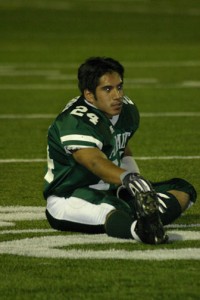Numerous athletes and teams believe that winning a game cannot be accomplished without proper stretching, while others deem the act of stretching a pure waste of time. The controversy of stretching is a daily battle between sports organizations and personal views of players. For some athletes, stretching can damage their performance, but in other cases it can enhance their game. Whether or not stretching really is effective comes down to the basics.

For years, athletic trainers, coaches and physical therapists have preached the importance of stretching before and after any practice or game. To prevent injury and prepare for big games, players follow the ritual of stretching to make a smooth transition from warm-up to game time. Although stretching has been integrated in most athletes’ warm-ups from a young age, many wonder whether or not it is helpful in its whole.
“I definitely think that [stretching] is an important part of warm-ups and cool-downs for all sports,” Palo Alto High School athletic trainer Josh Goldstein said. “[Stretching] elongates the muscles and prepares them for hard workouts.”
According to the Health Department in Sedgwick County, Kansas, stretching helps raise body temperature, increase blood flow and promote oxygen supply to muscles in warm-ups. In cool-downs, stretching prevents blood and other waste products from pooling up in limbs and muscles, and also by helping muscles and tendons relax and loosen.
“Stretching before and after workouts is equally important because it is critical to warm-up and prevent the potential micro-tears that occur every time you run,” Goldstein said. “Stretching afterwards helps loosen muscles and keep them from getting sore.”
Although a number of athletes feel that stretching may not actually be effective, Palo Alto Medical Foundation physical therapist Haideh Plock believes that stretching is something that should be considered by all athletes because of the many advantages stretching provides.
“If you are active [in stretching] or plan on becoming active, you need to maintain a balance between strength and flexibility,” Plock said. “If you are strong, but not flexible, you may be setting yourself up for injury. Many sports or activities require a rapid response from muscles. If those muscles are ‘too tight’ and you ask them to respond in a rapid manner, you can cause the muscle injury. You can also be too flexible; this leads to injury from instability in the joint.”
Despite qualified professional’s opinions, many still believe that stretching does not really help.
“I never have and never will [stretch],” varsity cross-country runner Josh Newby (’10) said. “I think stretching makes you feel like spaghetti before races, I just don’t like it. Afterwards, I just do it if I’m sore, and even then I’m careful doing it so that I don’t exacerbate my muscles.”
At cross-country practices, stretching is not even incorporated into the schedule.
“Personally, I don’t think that [stretching] is necessary,” Joe Ginanni, the Palo Alto High School boys’ varsity cross-country head coach said. “If kids on the team want to do it, that’s great, but unless someone is super sore in an area, I don’t usually tell them to stretch just to stretch.”
In 2004, Stephen B. Thacker, the director of the epidemiology program office at the Center for Disease Control, conducted a study that reviewed 361 research studies on stretching. Thacker’s research, published in the March edition of the Medicine and Science in Sports and Exercise magazine, concluded that stretching before or after workouts does not prevent muscle soreness or injury. While the study noted that stretching improves flexibility, flexibility does not prevent injury.
Therefore, the question of stretching comes up once again. There is not enough evidence according to the study to determine whether or not to stop or continue stretching. If stretching feels good, keep going; but if it is a pain, take a break and focus on strength building.




